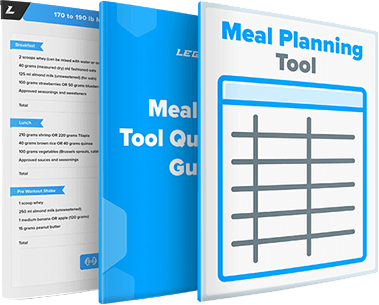Listen on Apple Podcasts | Listen on Spotify | Listen on YouTube
Clap your hands if you’ve heard this one before:
“Muscles don’t know weight, only tension.”
It’s an old bodybuilding saw that’s been around for decades, and it’s shorthand for the theory that the key driver of muscle growth is how long your muscles are working (contracting) during your workouts.
For example, if you do one set of 8 reps and each rep takes about 5 seconds, your time under tension for that set is 40 seconds (8 x 5). If you do three sets of the exercise, your total time under tension is 120 seconds (40 x 3).
According to proponents of this idea, the more time under tension you rack up over days, weeks, months, and years of training, the more muscle you’ll gain more or less regardless of any other training variable (intensity, frequency, volume, etc.).
Is this true, though? Is time under tension really the biggest lever you can pull to build muscle?
Not really.
You see, time under tension is an important element of the training stimulus that produces muscle growth, but it’s best to think of it as a byproduct of proper training rather than a target in its own right.
Let’s find out why.
Time Stamps:
3:16 – What does time under tension mean?
7:52 – What do studies say about time under tension?
13:28 – How should I program time under tension?
What did you think of this episode? Have anything else to share? Let me know in the comments below!
Transcript:
Hello, and welcome to a new episode of Muscle for Life. I’m Mike Matthews. Thank you for joining me today to learn about time under tension and how it relates to muscle building and whether or not you should take special actions to maximize it in your training. Now, clap your hands if you have heard this one before.
Muscles don’t know weight only tension. That’s an old body building. Saw that’s been around for decades now, and it is shorthand for the theory that the key driver of muscle growth is how long your muscles are working for are contracting for during your training. So for example, if you do one set of.
Eight reps and each rep takes about five seconds. Your time under tension for that set would be about 40 seconds. Now, if you do three sets of the exercise, then your total time under tension would be three times that, something around two minutes, right? 120 seconds. Now, according to proponents of the preeminence of time under tension, the more.
Time under tension. You rack up over days, weeks, months, and years of training, the more muscle you’ll gain, more or less, regardless of any other training variable like intensity or frequency or volume, or even progressive overload. Is that true though? Is time under tension really the biggest lever you can pull to build muscle and to get stronger?
No, not really. As you’ll learn in this podcast time inter. Is an important element of the training stimulus that produces muscle growth, but it is best to think of time and retention as a byproduct of proper training rather than a target in its own right. Also, if you like what I’m doing here on the podcast and elsewhere, definitely check out my health and fitness books, including the number one best selling weightlifting books for men and women in the world.
Bigger, leaner, stronger. Thinner, leaner, stronger, as well as the leading flexible dieting cookbook, the Shredded Chef. Now, these books have sold well over 1 million copies and have helped thousands of people build their best body ever, and you can find them on all major online retailers like Audible, Amazon, iTunes, Cobo, and Google Play, as well as.
In Select Barnes and Noble stores. And I should also mention that you can get any of the audiobooks 100% free when you sign up for an Audible account. And this is a great way to make those pockets of downtime like commuting, meal prepping, and cleaning more interesting, entertaining, and productive. And so if you want to take audible up on this offer, and if you want to get one of my audiobooks for free, just go to www.buy leg.
That’s B U Y legion.com/audible and sign up for your account. So again, if you appreciate my work and if you wanna see more of it, and if you wanna learn time proven and evidence-based strategies for losing fat, building muscle and getting healthy, and strategies that work for anyone and everyone, regardless of age or circumstances, please do consider picking up one of my best selling books, bigger, lean or Stronger.
Thinner, leaner, stronger for women, and the shredded chef for my favorite fitness friendly recipe. All right, so let’s start this discussion with a more technical exploration of time under tension. Now, I mentioned in the intro that it refers to the total amount of time that a muscle remains contracted.
So if you do three sets of. Eight reps of biceps curls, for example, and each rep takes just three seconds. Your time under tension would be 72 seconds for those three sets. And then if you did that twice per week, your weekly time under tension for your biceps would be about 144 seconds, assuming you didn’t do any other biceps exercises during the week, or pull exercises that indirectly train the biceps, which is unlikely if you’re following a good training program, but you get the.
Pretty simple right now when we’re talking about muscle hypertrophy. It is just as important to understand what time under tension isn’t though, because it is not the same as tension or mechanical tension, which refers to how hard you’re contracting a muscle during an exercise. How much. Force it produces when it contracts.
And to ensure that we don’t get these terms mixed up, I will use the term absolute tension to talk about that force that the muscle is producing and then time under tension to refer to how long muscles are remaining contracted For now, nearly every credible fitness researcher, coach and expert out there acknowledges that making your muscles contract forcefully.
Absolute tension is vital for gaining muscle, but some people claim that maximizing the amount of contraction time, the time under retention is even more so. For instance, a proponent of the primacy of time under tension would argue that three sets of eight slower reps, let’s say five second reps instead of three second reps of barbell curls with just 40 pounds for a total of 120 seconds of time under tension would be superior.
Muscle growth to, let’s say three sets of six normal, maybe two or three second reps with 60 pounds, because that would only give us about 36 seconds of time under tension. Now, depending on who you are listening to and how good they are at persuading people of their ideas, you might come away convinced that this person is correct.
That time under tension does seem to be a primary or even the primary driver of muscle growth. Well, While time. Inter tension is certainly important for building muscle, it is certainly connected to muscle building. Research shows that in order for it to contribute to meaningful amounts of muscle growth, you also need to be using sufficiently heavy weights, and to put a number to that, I would say at least 60% of your one max, and practically speaking, probably 70% or.
And so what that means then is if a weight is not heavy enough, it isn’t likely to stimulate much muscle growth, no matter how much time under tension you produce with it. What’s more, as your muscles get stronger, they can produce more absolute tension. So a weight. That is difficult and effective for building muscle today will be less so several months from now as you get stronger.
Therefore, to keep gaining muscle logic would dictate that you need to keep adding weight to the bar and to the dumbbells, and that is mostly correct. That process is probably familiar to you, and it is known as progressive tension overload or just progressive overload and studies going back to the seventies, show that it is the foremost mechanical factor.
In muscle growth, it is the primary determinant of how big and strong you get from your training. And that brings us to the biggest problem with focusing exclusively on time. Under tension, it can hamper your ability to achieve progressive overload. For instance, the most common method of increasing time under tension in a workout is just slowing down.
And this is a popular technique because it’s easy and it feels like your muscles are really working overtime. But it is a classic example of stepping over dollars to pick up dimes because it requires that you use much lighter weights. So let’s say you can bench 225 pounds for five normal. Reps, relatively fast reps.
If you want to slow that down to, let’s say five or six seconds per rep, you’re gonna have to reduce that weight quite a bit. It’s probably gonna have to drop to maybe 185 pounds or even less. And that dramatic reduction in load in intensity is enough to hobble. Your progress. A good example of this effect comes from a study conducted by scientists at the Federal University of South Carlos.
In this case, the researchers had 12 trained men, aged 18 to 30, do two workouts of three sets of leg press to failure using 80% of their one rep max. Half of those subjects were allowed to raise and lower the weight using. weightlifting tempo, whatever speed they wanted, which was the normal one, and it worked out to about 2.6 seconds per rep on average.
And then the other half were forced to lower the weight in two seconds and then raise the weight in two seconds. So each rep took a total of four seconds. Then both of the groups switched and the weightlifters who were allowed to self-select their tempo were forced to take the four second. Pace and vice versa.
And despite racking up almost 40% more time under tension when using the slower tempo, the subjects in this study were able to do about 60% more total reps when they used a faster tempo on the whole. This translated into much more total. Work done wait times reps, and that produced a more powerful muscle building stimulus.
There’s also an earlier study that was conducted by scientists at Springfield College that found almost the same results using the bench press, and there are at least five other studies that I know of that have reached a similar conclusion, and that is that reducing load to increased time under tension only decreases the effectiveness of your.
Now there are other ways to increase time under tension too, but none of them are worthwhile. For example, very high rep, low weight sets produce a lot of time under tension, but most research shows that they are no more effective than lower rep higher weight training. And in some cases they are less effective, especially when the.
Too light when you dip beneath that 60% of one rep max threshold, for example, many bodybuilders also use short rest periods, so 90 seconds or less in between sets to do more reps per workout. And of course that helps them rack up more time under tension. But studies show that this. Almost always results in worse muscle and strength gains because it impairs performance too much in each set.
You are not able to keep the heavy weight on the bar and maximize your performance with it if you cut your rest periods like that. Taking every set to absolute muscle failure is another way to inject a little more time under tension into your training. But once again, studies show that this is no better than and often inferior to just ending a reper two shy of muscle failure.
And pushing to absolute muscle failure too often and on the wrong exercises can also increase your risk of injury. Yet another way to dramatically spike time under tension in your training is to follow. an extremely high volume program like German volume training, for example, that yes produces a ton of time under tension, but research shows that this approach appears to be less effective than more moderate volume plans.
Now, with all of that said, I’m not saying that time under tension doesn’t matter, and you should make the mistake of just completely neglecting it because there is a school of body building that states that absolute tension, the absolute. Force that you force your muscles to generate is all that matters for muscle growth.
And so if you are willing to train with heavy enough weights, you can optimize your results with just a couple of intense weightlifting sessions per week. So for example, instead of doing, let’s say, 10 sets of bench press per week, or if you’re an intermediate or an advanced weightlifter, maybe. 15 or 16 sets of chest training wouldn’t have to just be bench press and let’s say you’re gonna be using moderately heavy weights for that style of training, which is the style of course, that I recommend something between maybe 75 and 95% in one rep max.
Some people would say that you could do just two or three sets per week with 95% or even up to 100% and gain just as much muscle and strength or maybe even. Well, studies show that that is wrong too. Yes, you need to lift heavy weights. You need to generate large amounts of absolute tension in your muscles if you wanna get bigger and stronger.
But you also need to do enough volume. And part of the reason for that is you do need to produce enough time under tension as well. And I’ve said this many times on the podcast, but I’ll repeat myself in case you. Have not heard me say it before. And optimal volume appears to be in the range of 10 to 20 hard sets.
That’s a working muscle building set per major muscle group per week, and you would count direct volume and indirect volume toward. The volume per major muscle group. So for example, if you are doing a barbell row, of course that is direct volume for your back and it is indirect volume for your biceps.
And so what that means then is you don’t have to try to record or manipulate your time under tension. Directly. You don’t have to know that by the end of the week you got 772 seconds of time under tension for your quads, and that means that you did a good job. Instead, you can just focus on training volume and ensure you are lifting heavy enough Weights.
And make sure that you are taking each hard set, close to muscle failure, maybe within a rep or two of muscle failure, but not all the way there, but also not well short of muscle failure. So not ending sets where you could do four or five or six reps, for example, unless you are following a more advanced training program that explicitly calls for that.
And then you can also just use a normal faster rep tempo, something like a 1 0 1, for example, one. Or so for the first part of the lift, and then basically no pause and one second for or so, give or take a little bit for the final part of the lift. So for example, on the squat, that would mean sitting down to depth in about a second and then going right into the ascent, which should also take.
About a second. Now, of course, when you get deeper into sets, maybe you are going to sit down in a second or so, but it takes you two seconds to stand up because you’re getting closer to muscle failure. That’s okay. But most of your reps, again, should be done quickly, not exaggeratedly. So, but just in a natural.
Rapid manner. And then as far as resting in between sets, you wanna make sure that you are not under resting to try to rack up more time under tension. And so I recommend anything between two and four minutes of rest in between each set. And I personally use two to two and a half minutes in between sets of accessory exercises.
So not the big compound lifts, not the squats, not the dead lifts, not the overhead presses, bench presses, and not some machine exercises like the leg press. I’m gonna rest probably three minutes in between the leg press, but only two minutes in between biceps curls, for example. And I don’t recommend resting more than four minutes or so because research shows.
Unlikely to improve your performance, and it’s just going to make your workout take longer. And if you rest for too long in between sets, your muscles can kind of cool down and it can be uncomfortable on your joints when you try to do your next hard set. And that’s it for this episode. Actually no reason to belabor the topic here.
The long story short is that time under tension is an important aspect of muscle building, but it is not an end in itself that you can profitably pursue in various ways like. Training, high volume training or super slow training. Just focus on enough volume, 10 to 20 hard sets per major Musk Cooper per week, using heavy weights, bringing each of your hard sets close to failure, and resting enough in between each set, and you will rack up more than enough time at retention to maximize.
Your gains and as for what is in the works and on the way, well, there is another best of muscle for life coming where you hear handpicked morsels from several of the most popular episodes I have published over the years, as well as another q and a where I’m going to answer questions about resistance bands getting laid.
Yep, seriously, and female lean gaining. And then the following week I have a monologue coming on the best time to lift weights according to dozens of studies. That’s something I get asked fairly often about. And an interview with Cooper Mitchell of garage jim reviews.com, where he breaks down everything you need to know to build an awesome home gym with a lot less money in space than you probably think You.
All right. Well, that’s it for this episode. I hope you enjoyed it and found it interesting and helpful. And if you did, and you don’t mind doing me a favor, please do leave a quick review on iTunes or. Wherever you’re listening to me from, in whichever app you’re listening to me in, because that not only convinces people that they should check out the show, it also increases search visibility.
And thus, it helps more people find their way to me and learn how to get fitter, leaner, stronger, healthier, and happier as well. And of course, if you want to be notified when the next episode goes, Then simply subscribe to the podcast and you won’t miss out on any new stuff. And if you didn’t like something about the show, please do shoot me an email at mike muscle for life.com.
Just muscle f o r life.com and share your thoughts on how I can do this better. I read everything myself, and I’m always looking for. Feedback, even if it is criticism, I’m open to it. And of course you can email me if you have positive feedback as well, or if you have questions really relating to anything that you think I could help you with, definitely send me an email.
That is the best way to get ahold of me, Mike, at muscle life.com. And that’s it. Thanks again for listening to this episode, and I hope to hear from you soon.
Scientific References +
- Barakat, C., Barroso, R., Alvarez, M., Rauch, J., Miller, N., Bou-Sliman, A., & De Souza, E. O. (2019). The Effects of Varying Glenohumeral Joint Angle on Acute Volume Load, Muscle Activation, Swelling, and Echo-Intensity on the Biceps Brachii in Resistance-Trained Individuals. Sports (Basel, Switzerland), 7(9), 204. https://doi.org/10.3390/sports7090204
- Lixandrão, M. E., Ugrinowitsch, C., Berton, R., Vechin, F. C., Conceição, M. S., Damas, F., Libardi, C. A., & Roschel, H. (2018). Magnitude of Muscle Strength and Mass Adaptations Between High-Load Resistance Training Versus Low-Load Resistance Training Associated with Blood-Flow Restriction: A Systematic Review and Meta-Analysis. In Sports Medicine (Vol. 48, Issue 2, pp. 361–378). Springer International Publishing. https://doi.org/10.1007/s40279-017-0795-y
- Amirthalingam, T., Mavros, Y., Wilson, G. C., Clarke, J. L., Mitchell, L., & Hackett, D. A. (2017). Effects of a modified German volume training program on muscular hypertrophy and strength. Journal of Strength and Conditioning Research, 31(11), 3109–3119. https://doi.org/10.1519/JSC.0000000000001747
- Carroll, K. M., Bazyler, C. D., Bernards, J. R., Taber, C. B., Stuart, C. A., DeWeese, B. H., Sato, K., & Stone, M. H. (2019). Skeletal Muscle Fiber Adaptations Following Resistance Training Using Repetition Maximums or Relative Intensity. Sports, 7(7), 169. https://doi.org/10.3390/sports7070169
- Nobrega, S. R., Ugrinowitsch, C., Pintanel, L., Barcelos, C., & Libardi, C. A. (2018). Effect of resistance training to muscle failure vs. volitional interruption at high-and low-intensities on muscle mass and strength. Journal of Strength and Conditioning Research, 32(1), 162–169. https://doi.org/10.1519/jsc.0000000000001787
- Henselmans, M., & Schoenfeld, B. J. (2014). The Effect of Inter-Set Rest Intervals on Resistance Exercise-Induced Muscle Hypertrophy. In Sports Medicine (Vol. 44, Issue 12, pp. 1635–1643). Springer International Publishing. https://doi.org/10.1007/s40279-014-0228-0
- Schoenfeld, B. J., Pope, Z. K., Benik, F. M., Hester, G. M., Sellers, J., Nooner, J. L., Schnaiter, J. A., Bond-Williams, K. E., Carter, A. S., Ross, C. L., Just, B. L., Henselmans, M., & Krieger, J. W. (2016). Longer interset rest periods enhance muscle strength and hypertrophy in resistance-trained men. Journal of Strength and Conditioning Research, 30(7), 1805–1812. https://doi.org/10.1519/JSC.0000000000001272
- Mangine, G. T., Hoffman, J. R., Gonzalez, A. M., Townsend, J. R., Wells, A. J., Jajtner, A. R., Beyer, K. S., Boone, C. H., Miramonti, A. A., Wang, R., LaMonica, M. B., Fukuda, D. H., Ratamess, N. A., & Stout, J. R. (2015). The effect of training volume and intensity on improvements in muscular strength and size in resistance-trained men. Physiological Reports, 3(8). https://doi.org/10.14814/phy2.12472
- Rana, S. R., Chleboun, G. S., Gilders, R. M., Hagerman, F. C., Herman, J. R., Hikida, R. S., Kushnick, M. R., Staron, R. S., & Toma, K. (2008). Comparison of early phase adaptations for traditional strength and endurance, and low velocity resistance training programs in college-aged women. Journal of Strength and Conditioning Research, 22(1), 119–127. https://doi.org/10.1519/JSC.0b013e31815f30e7
- Ki, E., Dea, A., Ferguso, S. L., Se, D., & Bembe, M. G. (2011). Effects of 4 weeks of traditional resistance training vs. superslow strength training on early phase adaptations in strength, flexibility, and aerobic capacity in college-aged women. Journal of Strength and Conditioning Research, 25(11), 3006–3013. https://doi.org/10.1519/JSC.0b013e318212e3a2
- Neils, C. M., Udermann, B. E., Brice, G. A., Winchester, J. B., & McGuigan, M. R. (2005). Influence of contraction velocity in untrained individuals over the initial early phase of resistance training. Journal of Strength and Conditioning Research, 19(4), 883–887. https://doi.org/10.1519/R-15794.1
- Munn, J., Herbert, R. D., Hancock, M. J., & Gandevia, S. C. (2005). Resistance training for strength: Effect of number of sets and contraction speed. Medicine and Science in Sports and Exercise, 37(9), 1622–1626. https://doi.org/10.1249/01.mss.0000177583.41245.f8
- Hatfield, D. L., Kraemer, W. J., Spiering, B. A., Häkkinen, K., Volek, J. S., Shimano, T., Spreuwenberg, L. P. B., Silvestre, R., Vingren, J. L., Fragala, M. S., Gómez, A. L., Fleck, S. J., Newton, R. U., & Maresh, C. M. (2006). The impact of velocity of movement on performance factors in resistance exercise. Journal of Strength and Conditioning Research, 20(4), 760–766. https://doi.org/10.1519/R-155552.1
- Headley, S. A., Henry, K., Nindl, B. C., Thompson, B. A., Kraemer, W. J., & Jones, M. T. (2011). Effects of lifting tempo on one repetition maximum and hormonal responses to a bench press protocol. Journal of Strength and Conditioning Research, 25(2), 406–413. https://doi.org/10.1519/JSC.0b013e3181bf053b
- Nóbrega, S. R., Barroso, R., Ugrinowitsch, C., Da Costa, J. L. F., Alvarez, I. F., Barcelos, C., & Libardi, C. A. (2018). Self-selected vs. fixed repetition duration: Effects on number of repetitions and muscle activation in resistance-trained men. Journal of Strength and Conditioning Research, 32(9), 2419–2424. https://doi.org/10.1519/JSC.0000000000002493
- Jaspers, S. R., Fagan, J. M., Satarug, S., Cook, P. H., & Tischler, M. E. (1988). Effects of immobilization on rat hind limb muscles under non‐weight‐bearing conditions. Muscle & Nerve, 11(5), 458–466. https://doi.org/10.1002/mus.880110508
- Schoenfeld, B. J. (2013). Is there a minimum intensity threshold for resistance training-induced hypertrophic adaptations? In Sports Medicine (Vol. 43, Issue 12, pp. 1279–1288). Sports Med. https://doi.org/10.1007/s40279-013-0088-z
- Schoenfeld, B. J. (2010). The mechanisms of muscle hypertrophy and their application to resistance training. In Journal of Strength and Conditioning Research (Vol. 24, Issue 10, pp. 2857–2872). J Strength Cond Res. https://doi.org/10.1519/JSC.0b013e3181e840f3










